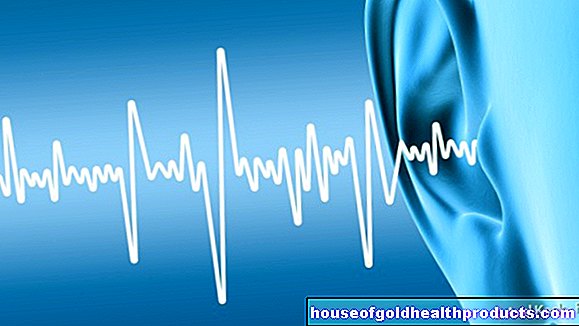Olanzapine
Updated on All content is checked by medical journalists.Olanzapine is one of the most important anti-schizophrenia drugs. It is also used to treat bipolar disorder. The active ingredient is generally considered to be better tolerated than the older antipsychotics, but can lead to severe weight gain. Here you can read everything you need to know about olanzapine: effect, use, side effects and interactions.
This is how olanzapine works
Olanzapine is a drug from the group of so-called atypical antipsychotics. It has an antipsychotic (against psychosis), antimanic (against a phase-wise strong increase in drive) and mood-stabilizing, which is why it is approved for the treatment of bipolar diseases in contrast to other antipsychotics.
In the brain and spinal cord (central nervous system), the interaction of various neurotransmitters ensures that one feels balanced and can react appropriately to certain situations (such as excitement, joy, fear, etc.). For this purpose, the various messenger substances (such as serotonin and dopamine) are released from nerve cells as required and later absorbed and stored again.
This balance of messenger substances is disturbed in people who suffer from schizophrenia or bipolar diseases. Olanzapine blocks certain docking points (receptors) of messenger substances, including those of dopamine and serotinin. The effect of these messenger substances can be brought back into balance. At the same time, olanzapine has a slightly calming effect.
Uptake, breakdown and excretion
After ingestion by mouth (orally), olanzapine is well absorbed from the intestine into the blood. The breakdown takes place in the liver with the participation of the enzyme CYP1A2. The breakdown products are mainly excreted via the kidneys.
When administered into the muscle (intramuscularly) as a depot injection, the active ingredient is gradually released from the depot formed over a longer period of time. However, breakdown and excretion remain identical to oral intake.
When is olanzapine used?
The areas of application (indications) for olanzapine include:
- schizophrenia
- Manic episode as part of a bipolar illness (if the patient responds to it, olanzapine is also suitable for preventing manic phases)
This is how olanzapine is used
The active substance olanzapine is usually taken in the form of tablets or orodispersible tablets. In acute cases, the active ingredient can also be injected directly into the blood.
Usually the daily dose is ten milligrams. If necessary, it can be increased gradually up to 20 milligrams a day. The full effect of olanzapine only develops several days to weeks after the start of treatment.
In patients who are stable on olanzapine, the active ingredient can be injected into the muscle as a depot injection to avoid daily tablet intake. The doctor in charge will then repeat the injection every two or four weeks.
What are the side effects of olanzapine?
Very often, i.e. in more than ten percent of those treated, olanzapine causes side effects such as weight gain and drowsiness.
Often (in one to ten percent of those treated), the treatment leads to changes in the blood count, dizziness, dry mouth, constipation and low blood pressure (especially when changing position quickly, e.g. getting up quickly from lying down).
What should be considered when taking olanzapine?
Contraindications
Olanzapine must not be used in:
- Angle-closure glaucoma (form of glaucoma)
Caution is also advised with:
- Enlargement of the prostate (prostatic hyperplasia)
- Pyloric stenosis (narrowing in the area of the stomach outlet)
- severe liver or kidney problems
Interactions
Olanzapine can increase the effects of blood pressure medication (e.g. ACE inhibitors, sartans, beta blockers) or sleeping pills (e.g. benzodiazepines, antihistamines) at the same time.
Alcohol increases the sedative effects of olanzapine.
You should consider these interactions especially when driving vehicles or operating heavy machinery.
Olanzapine is mainly broken down in the liver by the enzyme CYP1A2. Other drugs that block or induce this enzyme (increase its activity) can therefore increase or decrease the effects and side effects of olanzapine:
CYP1A2 inhibitors such as fluvoxamine (antidepressant) and ciprofloxazine (antibiotic) can increase the effects of olanzapine. CYP1A2 inducers such as carbamazepine (anti-epileptic drugs) and tobacco smoke can weaken the effect of olanzapine by accelerating the breakdown of the active ingredient.
Driving and using machines
As a side effect, drowsiness and dizziness may occur when taking olanzapine. Therefore, pay particular attention to the individual reaction to the drug, especially at the beginning of treatment.
Together with the doctor, it must then be decided whether active participation in road traffic or the use of heavy machinery is possible.
Age restrictions
There is very little experience with the use of olanzapine in children and adolescents. The treatment should therefore only be carried out by very experienced doctors if the individual benefit clearly outweighs the corresponding risk.
pregnancy and breast feeding period
According to experts, better tested alternatives (risperidone, quetiapine) should be used during pregnancy instead of olanzapine. However, if a woman is well adjusted to the active ingredient (good effectiveness with good tolerance), it can continue to be taken during pregnancy.
If olanzapine is used during pregnancy, adjustment disorders in the newborn may occur shortly after birth. Doctors need to pay careful attention to this.
No problems in the infant have been noted while breastfeeding when the mother was treated with olanzapine. Therefore, taking this active ingredient during breastfeeding is considered "acceptable".
How to get olanzapine medication
Medicines containing olanzapine require a prescription in Germany, Austria and Switzerland, as the success of the treatment has to be checked regularly by a doctor. You can therefore only get the medication with a prescription from the doctor in the pharmacy.
How long has olanzapine been known?
Olanzapine is a relatively new drug. It was developed from the so-called "classic antipsychotics", ie agents against psychological complaints, and was approved in Germany in 1996.
As a representative of the group of "atypical antipsychotics" (second generation antipsychotics), olanzapine has fewer side effects, but can lead to severe weight gain and disorders of lipid metabolism.
Tags: menopause therapies womenshealth





























